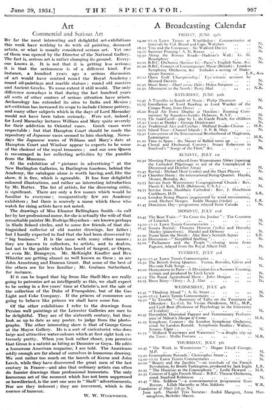Art
Commercial and Serious Art
BY far the most interesting and delightful art-exhibitions this week have nothing to do with oil painting, deceased artists, or what is usually considered serious art. Yet one of them was opened by the Director of the National Gallery. The fact is, serious art is rather changing its ground. Every- one knows. it.. It is not that it is getting less serious; it is that the seriousness is of a different kind. For instance, a hundred years ago a serious discussion of art would have centred round the Royal Academy : round oil-paintings and marble statues ;. round old masters and Ancient Greeks. To some extent it still would. The only difference nowadays is that during the last hundred years all sorts of other centres of serious attention have arisen. Archaeology has extended its sites to India and Mexico ; art-criticism has increased its scope to include Chinese pottery, and many other subjects which in the days of Lord Macaulay would not have been taken seriously. Were not, indeed ; for Lord Macaulay lectures William and Mary quite severely for their addiction to Oriental vases.. Greek vases were respectable ; but that Hampton Court should be made the repository of Japanese vases seemed to him shocking. Nowa- days the Japanese wares of William and Mary's date at Hampton Court and Windsor appear to experts to be some of the choicest of the royal treasures; and our own Queen is encouraged in her collecting activities by the pundits from the Museums.
At the exhibition of " pictures in advertising " at the New Burlington Galleries, in Burlington Gardens, behind the Academy, the catalogue alone is worth having, and, like the show, it is free, which is agreeable. It has four delightful coloured illustrations, and rather an interesting introduction by Mr. Rutter. The list of artists, for the discerning critic, is significant. There are only a few names which would be familiar to everyone ; comparatively few are Academy exhibitors ; but there is scarcely a name which those who watch for rising artists have not noted.
The drawings of Miss Eleanor Bellingham Smith-to call her by her professional name, for she is actually the wife of that remarkable painter Mr. Rodrigo Moynihan-are known perhaps in Slade School circles, and to some few friends of that dis- tinguished collector of old master drawings, her father ; but I hardly expected to find that she had been discovered by " big business." It is the same with many other names ; they are known to collectors, to artists, and to dealers, but not to the public which has heard of Sargent, or Orpen, or even Mr. Brangsryn. Mr. McKnight Kauffer and Rex Whistler are getting almost as well known as these ; so are Sohn Armstrong and Duncan Grant. But some of the best of the others are far less familiar ; Mr. Graham Sutherland, for instance.
If it can be hoped that big firms like Shell-Mex are really going to patronize art as intelligently as this, we shall expect to be seeing in a few years' time at Christie's, not the sale of the collection of the Duke of Frumpshire, but of the Gas Light and Coke Company. If the princes of commerce are going to behave like princes we shall have some fun.
Of the other exhibitions I refer to the drawings from Persian wall paintings at the Leicester Galleries are sure to be delightful. They are of the sixteenth century, but they look as up to date as any poster, to judge from the photo- graphs. The other interesting show is that of George Grosz at the Mayor Gallery. He is a sort of caricaturist who does large and attractive water-colours which at first sight look ex- tremely pretty. When you look rather 'closer, you perceive that Grosz is a satirist as biting as Daumier or Goya. He edits a humorous American magazine; I am told. The Americans oddly enough are far ahead of ourselves in humorous drawing. We rest rather too much on the laurels of Keene and John Leech, while they have discovered the great men of the last century in France-and also that ordinary artists can often do funnier drawings than professional humorists. The only humorous art of the moment which has not been suppressed or bowdlerized, is the sort one sees in " Shell" advertisements. Nor are they indecent ; they are irreverent, which is the essence of humour.
W. W. WINKWORT11.




































 Previous page
Previous page